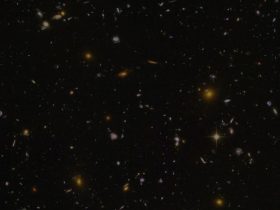The James Webb Space Telescope and other observatories witnessed a massive explosion in space that created rare chemical elements, some of which are necessary for life.
The explosion, which occurred on March 7, was the second brightest gamma-ray burst ever witnessed by telescopes in more than 50 years of observations, over one million times brighter than the entire Milky Way Galaxy combined. Gamma-ray bursts are short emissions of the most energetic form of light.
This particular burst, called GRB 230307A, was likely created when two neutron stars — the incredibly dense remnants of stars after a supernova — merged in a galaxy about one billion light-years away. In addition to releasing the gamma-ray burst, the merger created a kilonova, a rare explosion that occurs when a neutron star merges with another neutron star or a black hole, according to a study published Wednesday in the journal Nature.
“There are only a mere handful of known kilonovas, and this is the first time we have been able to look at the aftermath of a kilonova with the James Webb Space Telescope,” said lead study author Andrew Levan, astrophysics professor at Radboud University in the Netherlands. Levan was also part of the team that made the first detection of a kilonova in 2013.
In addition to Webb, NASA’s Fermi Gamma-ray Space Telescope, Neil Gehrels Swift Observatory, and the Transiting Exoplanet Survey Satellite observed the burst and traced it back to the neutron star merger. Webb was also used to detect the chemical signature of tellurium within the aftermath of the explosion.
Tellurium, a rare metalloid, is used to tint glass and ceramics and has a role in the manufacturing process of rewritable CDs and DVDs, according to the Royal Society of Chemistry. Astronomers expect that other elements close to tellurium on the periodic table, including iodine, which is necessary for much of life on Earth, is likely to be present in the material released by the kilonova.
“Just over 150 years since Dmitri Mendeleev wrote down the periodic table of elements, we are now finally in the position to start filling in those last blanks of understanding where everything was made, thanks to Webb,” Levan said.
Tracking stellar explosions
Astronomers have long believed that neutron star mergers are the celestial factories that create rare elements heavier than iron. But it’s been difficult to track down the evidence.
Kilonovae are rare events, which makes them difficult to observe. But astronomers look for short gamma-ray bursts, which only last about two seconds at the longest, as the telltale byproducts of the scarce events.
What was unusual about this burst is that it lasted for 200 seconds, making it a long gamma-ray burst. Such extended bursts are usually associated with supernovas created when massive stars explode.
“This burst is way into the long category. It’s not near the border. But it seems to be coming from a merging neutron star,” said study coauthor Eric Burns, assistant professor of physics and astronomy at Louisiana State University, in a statement.
Fermi initially detected the gamma-ray burst, and astronomers used ground- and space-based observatories to track the changes in brightness during the aftermath of the explosion in gamma-ray, X-ray, visible, infrared and radio waves of light. The quick changes in visible and infrared light suggested it was a kilonova.
“This type of explosion is very rapid, with the material in the explosion also expanding swiftly,” said study coauthor Om Sharan Salafia, a researcher at the National Institute for Astrophysics’ Brera Astronomical Observatory in Italy, in a statement. “As the whole cloud expands, the material cools off quickly and the peak of its light becomes visible in infrared, and becomes redder on timescales of days to weeks.”
The team also used Webb to trace the journey of the neutron stars before they exploded.
Once, they were two massive stars in a binary system that existed in a spiral galaxy. One of the pair exploded as a supernova, leaving behind a neutron star, and then the same thing happened to the other star. These explosive events launched the stars from their galaxy and they remained as a pair, traveling for 120,000 light-years before merging several hundred million years after being ejected from their home.
Finding cosmic elements
Astronomers have been trying to determine how chemical elements are created in the universe for decades.
Discovering more kilonovas in the future with sensitive telescopes like Webb and the Nancy Grace Roman Space Telescope, set to launch in 2027, could provide insights into which heavy elements are created and released by the rare explosions.
The researchers also want to find more mergers that create longer gamma-ray bursts to determine what drives them and whether there is any connection to the elements created in the process.
The violent life cycle of stars has distributed the elements found on the periodic table throughout the universe, including those necessary for life to form on Earth in the first place. The ability to study stellar explosions like kilonovas in recent years is enabling scientists to answer questions about the formation of chemical elements, allowing for a deeper understanding of how the universe has evolved over time.
“Webb provides a phenomenal boost and may find even heavier elements,” said study coauthor Ben Gompertz, assistant professor at the Institute for Gravitational Wave Astronomy and the School of Physics and Astronomy at the University of Birmingham in the United Kingdom, in a statement.
“As we get more frequent observations, the models will improve and the spectrum may evolve more in time,” Gompertz said. “Webb has certainly opened the door to do a lot more, and its abilities will be completely transformative for our understanding of the universe.”






